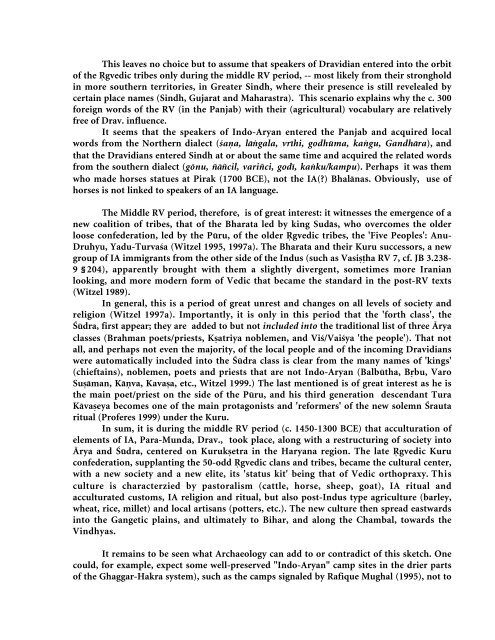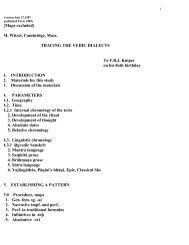The Languages of Harappa - People Fas Harvard
The Languages of Harappa - People Fas Harvard
The Languages of Harappa - People Fas Harvard
Create successful ePaper yourself
Turn your PDF publications into a flip-book with our unique Google optimized e-Paper software.
This leaves no choice but to assume that speakers <strong>of</strong> Dravidian entered into the orbit<br />
<strong>of</strong> the gvedic tribes only during the middle RV period, -- most likely from their stronghold<br />
in more southern territories, in Greater Sindh, where their presence is still revelealed by<br />
certain place names (Sindh, Gujarat and Maharastra). This scenario explains why the c. 300<br />
foreign words <strong>of</strong> the RV (in the Panjab) with their (agricultural) vocabulary are relatively<br />
free <strong>of</strong> Drav. influence.<br />
It seems that the speakers <strong>of</strong> Indo-Aryan entered the Panjab and acquired local<br />
words from the Northern dialect (śaa, lågala, vrīhi, godhūma, kagu, Gandhåra), and<br />
that the Dravidians entered Sindh at or about the same time and acquired the related words<br />
from the southern dialect (gōnu, ñåñcil, variñci, godī, kaku/kampu). Perhaps it was them<br />
who made horses statues at Pirak (1700 BCE), not the IA(?) Bhalånas. Obviously, use <strong>of</strong><br />
horses is not linked to speakers <strong>of</strong> an IA language.<br />
<strong>The</strong> Middle RV period, therefore, is <strong>of</strong> great interest: it witnesses the emergence <strong>of</strong> a<br />
new coalition <strong>of</strong> tribes, that <strong>of</strong> the Bharata led by king Sudås, who overcomes the older<br />
loose confederation, led by the Pūru, <strong>of</strong> the older gvedic tribes, the 'Five <strong>People</strong>s': Anu-<br />
Druhyu, Yadu-Turvaśa (Witzel 1995, 1997a). <strong>The</strong> Bharata and their Kuru successors, a new<br />
group <strong>of</strong> IA immigrants from the other side <strong>of</strong> the Indus (such as Vasiha RV 7, cf. JB 3.238-<br />
9 §204), apparently brought with them a slightly divergent, sometimes more Iranian<br />
looking, and more modern form <strong>of</strong> Vedic that became the standard in the post-RV texts<br />
(Witzel 1989).<br />
In general, this is a period <strong>of</strong> great unrest and changes on all levels <strong>of</strong> society and<br />
religion (Witzel 1997a). Importantly, it is only in this period that the 'forth class', the<br />
Śūdra, first appear; they are added to but not included into the traditional list <strong>of</strong> three Ārya<br />
classes (Brahman poets/priests, Katriya noblemen, and Viś/Vaiśya 'the people'). That not<br />
all, and perhaps not even the majority, <strong>of</strong> the local people and <strong>of</strong> the incoming Dravidians<br />
were automatically included into the Śūdra class is clear from the many names <strong>of</strong> 'kings'<br />
(chieftains), noblemen, poets and priests that are not Indo-Aryan (Balbūtha, Bbu, Varo<br />
Suåman, Kåva, Kavaa, etc., Witzel 1999.) <strong>The</strong> last mentioned is <strong>of</strong> great interest as he is<br />
the main poet/priest on the side <strong>of</strong> the Pūru, and his third generation descendant Tura<br />
Kåvaeya becomes one <strong>of</strong> the main protagonists and 'reformers' <strong>of</strong> the new solemn Śrauta<br />
ritual (Pr<strong>of</strong>eres 1999) under the Kuru.<br />
In sum, it is during the middle RV period (c. 1450-1300 BCE) that acculturation <strong>of</strong><br />
elements <strong>of</strong> IA, Para-Munda, Drav., took place, along with a restructuring <strong>of</strong> society into<br />
Ārya and Śūdra, centered on Kuruketra in the Haryana region. <strong>The</strong> late gvedic Kuru<br />
confederation, supplanting the 50-odd gvedic clans and tribes, became the cultural center,<br />
with a new society and a new elite, its 'status kit' being that <strong>of</strong> Vedic orthopraxy. This<br />
culture is characterzied by pastoralism (cattle, horse, sheep, goat), IA ritual and<br />
acculturated customs, IA religion and ritual, but also post-Indus type agriculture (barley,<br />
wheat, rice, millet) and local artisans (potters, etc.). <strong>The</strong> new culture then spread eastwards<br />
into the Gangetic plains, and ultimately to Bihar, and along the Chambal, towards the<br />
Vindhyas.<br />
It remains to be seen what Archaeology can add to or contradict <strong>of</strong> this sketch. One<br />
could, for example, expect some well-preserved "Indo-Aryan" camp sites in the drier parts<br />
<strong>of</strong> the Ghaggar-Hakra system), such as the camps signaled by Rafique Mughal (1995), not to

















